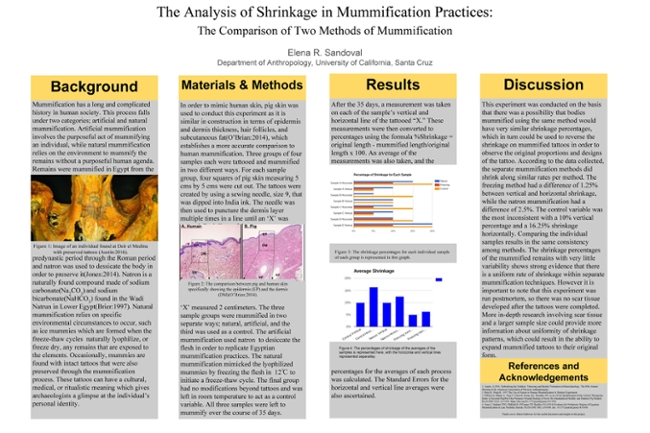Looking into the ‘Soul’ of Mummies - via Tattoos
Looking into the ‘Soul’ of Mummies - via Tattoos
By Naima Tucker, Anthropology Major
“Tattoos are one of the few things left behind that bioarchaeologists can study that are more of a representation of a person’s soul than just quantitative analysis on age, sex, and stature,” says Anthropology Major Elena Sandoval. “Tattoos have more of a social and ritualized concept which gives insight into who they were as a person instead of simply what they were.” Sandoval’s research treated tattoo shrinkage consistencies with two different mummification processes: desiccation using natron (like in Ancient Egypt) and lyophilization using freezing (as known in the case of Otzi the Iceman).
Elena Sandoval performed research on how mummification effects tattoos. Photo By Naima Tucker.
Elena has always been interested in mummies and had previously attended two separate talks discussing them, one by Bob Brier in which he discussed an experiment where he mummified a human cadaver using methods from ancient Egypt to discover how the tools were used in this process. The other was by Anne Austin, discussing tattoos found on a possible mummified priestess in Egypt. These two talks sparked Sandoval’s interest further and compelled her to combine both of their research topics in her study.
Her advisor was Dr. Alison Galloway, with whom she connected while working in the Anthropology labs over summer. After meeting a few times, she approached Galloway about overseeing her senior thesis. Dr. Galloway provided her with tools on how to conduct research in a scientific way, then let Elena run the experiments from there. Elena is grateful that she was allowed quite a bit of freedom in her study as it allowed for a more independent and less structured environment where she was able to move at her own pace and study what she wanted to study.
Elena also participated in the Undergraduate Research Symposium, where she was asked questions about how and why she became interested in her chosen subject matter. She recalls that the staff and faculty who attended were a nice audience and supportive to all of the students presenting, which helped calm her nerves about public speaking.
Presenting alongside Sandoval at this year’s Undergraduate Research Symposium were Alec Apodaca on indigenous clam bed management at Colonial Period Toms Point, for which he received a Dean’s Award; and Luisa Zepeda on the chemex, a coffee apparatus of the 1940s which, as she says, “Embodies cross-cultural rituals of coffee-making yet ... remains secular, modern, and non cultural.”
Naima Tucker is a Peer Adviser with the Department of Anthropology.

